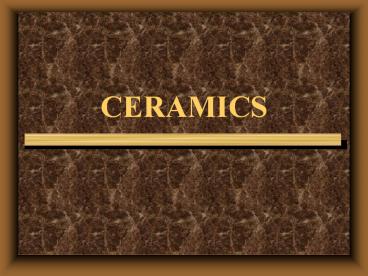CERAMICS - PowerPoint PPT Presentation
Title:
CERAMICS
Description:
and porcelain. Earthenware. Earthenware is a low-fire clay that is porous ... Slip is an inevitable byproduct of working on a potter's wheel, its name having ... – PowerPoint PPT presentation
Number of Views:177
Avg rating:3.0/5.0
Title: CERAMICS
1
CERAMICS
2
CLAY
- Mud moist, sticky dirt.
- In ceramics, clay is fine-grained,firm earthy
material that is plastic when wet, brittle when
dry, and very hard when heated.
3
The most common types of ceramic clays are
- earthenware,
- stoneware,
- and porcelain.
4
Earthenware
- Earthenware is a low-fire clay that is porous
and not waterproof.
5
Greenware
- Greenware generally refers to unfired pottery.
6
Bone Dry
- In ceramics, greenware which is thoroughly room
dried is said to be bone dry.
7
Leather-hard
- In ceramics, leather hard is a state in which
clay has lost moisture to evaporation, but has
not yet completely hardened. The clay is damp
enough to be joined to other pieces with scoring
and slip.
8
Firing
- Firing is the process of baking and hardening
pottery. Traditional Indian pottery is fired
outdoors (rather than in a kiln) using various
fuels including dried animal dung.
9
Firing Clay
- Clay is hardened by heating it to a high
temperature, thus fusing the clay particles.
Temperature in kilns can reach 2500 degrees.
10
Kiln
- A kiln is a furnace in which ceramics are fired.
Kilns can be electric, natural gas, wood, coal,
fuel oil or propane.
11
Slab Built
- Clay slabs are cut to shape and joined together
using scoring and wet clay called slip. Slabs can
be draped over or into forms, rolled around
cylinders or built-up into geometric forms.
12
Slip
- Slip is a fine, liquid form of clay that is
applied to the surface of a vessel prior to
firing. - slip is made by mixing finely ground clay with
water.
13
Slip
- Slip is an inevitable byproduct of working on a
potter's wheel, its name having resulted from
potters' use of water to keep the spinning clay
slippery as it's worked.
14
Slip
- It is also used to cement together parts that
have been formed separately.
15
Scoring
- Making scratches or creases in pieces of clay to
be joined together is called scoring.
16
Scoring
- Scoring and applying slip to such roughened
surfaces creates a bond that holds the pieces
together.
17
Scoring
- If slip acts as an adhesive, and scoring makes
two pieces of clay like the opposite sides of a
zipper, their combined action-- a zipped zipper
with hardened adhesive inside-- should be
permanent.
18
Glaze
- Glaze is a coating of material applied to
ceramics before firing that forms a glass-like
surface.
19
Glaze
- colored,
- opaque,
- translucent
- or matte.































